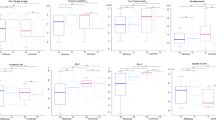Abstract
One hundred and ten patients (179 eyes) with reduced visual acuity caused by different ocular disorders underwent visual rehabilitation with an instrument for biofeedback: improved biofeedback integrated system (Ibis). One hundred and fourteen eyes had age-related macular degeneration, 39 eyes had myopic macular degeneration, and 26 eyes were affected by different ocular disorders. A placebo training was developed on 34 patients (47 eyes). Thirty-three eyes had age-related macular degeneration and 15 eyes had myopic macular degeneration. Visual acuity was found to be improved in 130/179 eyes (72.62%). Mean visual acuity was 0.24 before training and 0.36 at the last follow-up. A review of the literature and possible mechanisms are discussed.
Similar content being viewed by others
References
Abadi, R. V., Carden, D., & Sinpson, J. (1980). A new treatment for congenital nystagmus. British Journal of Ophthalmology, 64, 2–6.
Allen, M. J. (1954). Dependence of cyclophoria on convergence, elevation, and the system of axes. American Journal of Optometry, 31, 297.
Balliet, R., & Nakayama, K. (1978). Training of voluntary torsion. Investigative Ophthalmology, 17, 303–314.
Bangerter, A. (1955). Amblyopiebehandlung (2nd ed.). New York: Basel, Karger.
Böhme, G. (1955). Zur Kenntnis der exzentrischen fixation im hinblick auf die behandlung der amblyopie. Klinische Monatsblatter fur Augenheilkunde, 126, 694–719.
Ciuffreda, K. J., Goldrich, S. G., & Neary, C. (1982). Use of the eye movement auditory feedback in the control of nystagmus. American Journal of Optometry and Physiological Optics, 59, 396–409.
Contestabile, M. T., Recupero, S. M., Palladino, D., De Stefanis, M., Abdolrahimzadeh, S., Suppressa, F., & Balacco Gabrieli, C. (2002). A new method of biofeedback in the management of low vision. Eye, 16, 472–480.
Cummings, R. W., Whittaker, S. G., Watson, S. G., & Budd, J. M. (1985). Scanning characters and reading with a central scotoma. American Journal of Optometry and Physiological Optics, 62, 833–843.
Flom, M. C., Kirschen, D. G., & Bedell, H. E. (1980). Control of unsteady, eccentric fixation in amblyopic eyes by auditory feedback of eye position. Investigative Ophthalmology and Visual Science, 19, 1371–1381.
Fossetti, A. (1962). The management of myopia by biofeedback visual training. International Conference of Optometry, Riga.
Iorio, P., Albergo, V., Bianco, G., Spadea, L., Rapinese, M., Gallenga, P. E., & Balestrazzi, E. (1998). Fotostimolazione visiva e ipovisione. Ottica Fisiopatologica, 3, 39–44.
Leung, V., Wick, B., & Bedell, H. E. (1996). Multifaceted treatment of congenital nystagmus: A report of 6 cases. Optometry and Vision Science, 73, 114–124.
Moncada, A. (1995). Il biofeedback visivo: Origini, ipotesi fisiologiche, applicazioni. Atti SIRV, Roma, Italy, pp. 6–11.
Rotberg, M. H. (1983). Biofeedback for ophthalmologic disorders. Survey of Ophthalmology, 27, 381–386.
Rowan, G. E., & Sedlacek, K. (1981). Biofeedback in the treatment of blefarospasm: A case study. American Journal of Psychiatry, 138, 1487–1489.
Roxanas, M. R., Thomas, M. R., & Rapp, M. S. (1978). Biofeedback treatment of blefarospasm with spasmodic torticollis. Canadian Medical Association, 119, 48–49.
Russ, K. L., Kass, M., & O'Connell, M. F. (1978). EMG biofeedback applied to patients with elevated intraocular pressure. Biofeedback and Self-Regulation, 3, 231.
Trachtman, J. N. (1978). Biofeedback of accommodation to reduce myopia. A case report. American Journal of Optometry and Physiological Optics, 55, 400–406.
Trachtman, J. N. (1987). Biofeedback of accomodation to reduce myopia: A review. American Journal of Optometry and Physiological Optics, 64, 639–643.
Whittaker, S. G., Budd, J., & Cummings, R. W. (1988). Eccentric fixation with macular scotoma. Investigative Ophthalmology and Visual Science, 29, 268–278.
Author information
Authors and Affiliations
Corresponding author
Rights and permissions
About this article
Cite this article
Giorgi, D., Contestabile, M.T., Pacella, E. et al. An Instrument for Biofeedback Applied to Vision. Appl Psychophysiol Biofeedback 30, 389–395 (2005). https://doi.org/10.1007/s10484-005-8424-1
Issue Date:
DOI: https://doi.org/10.1007/s10484-005-8424-1




